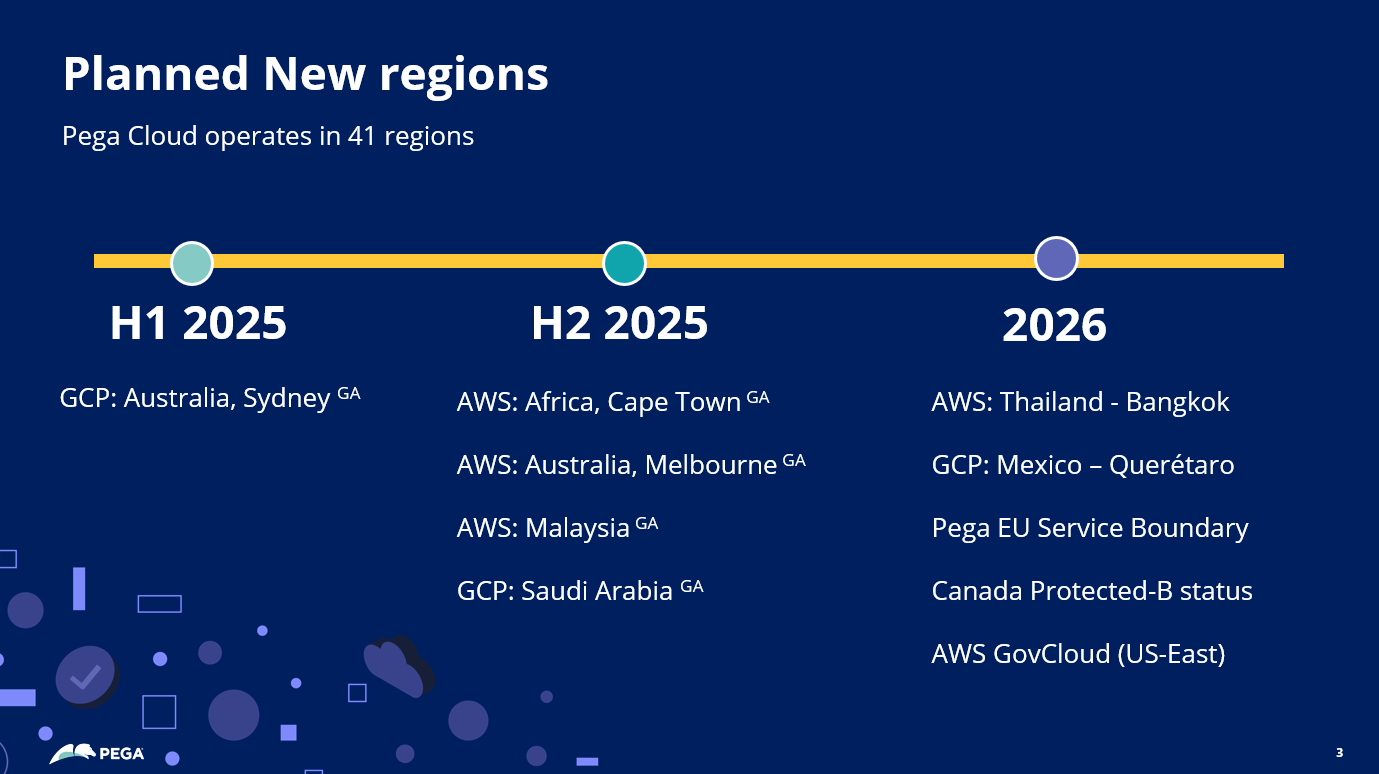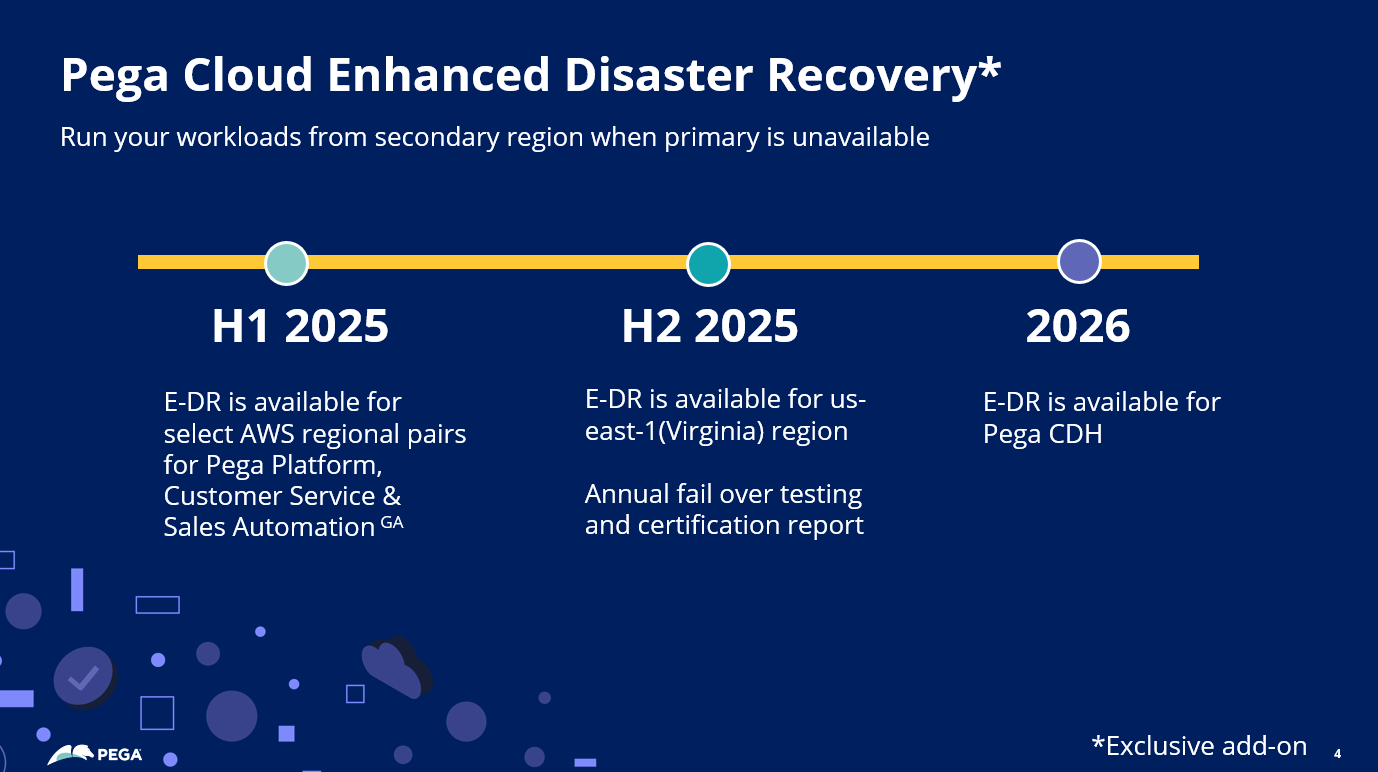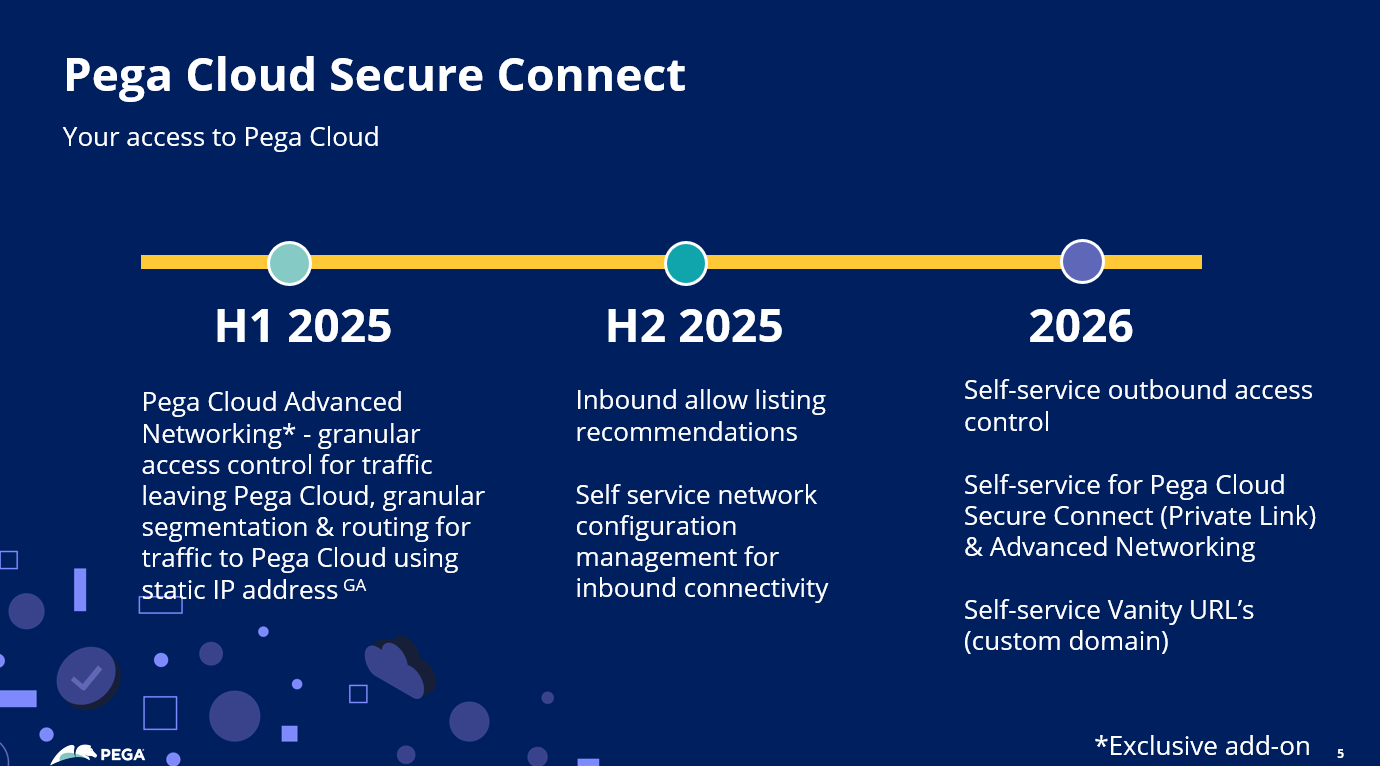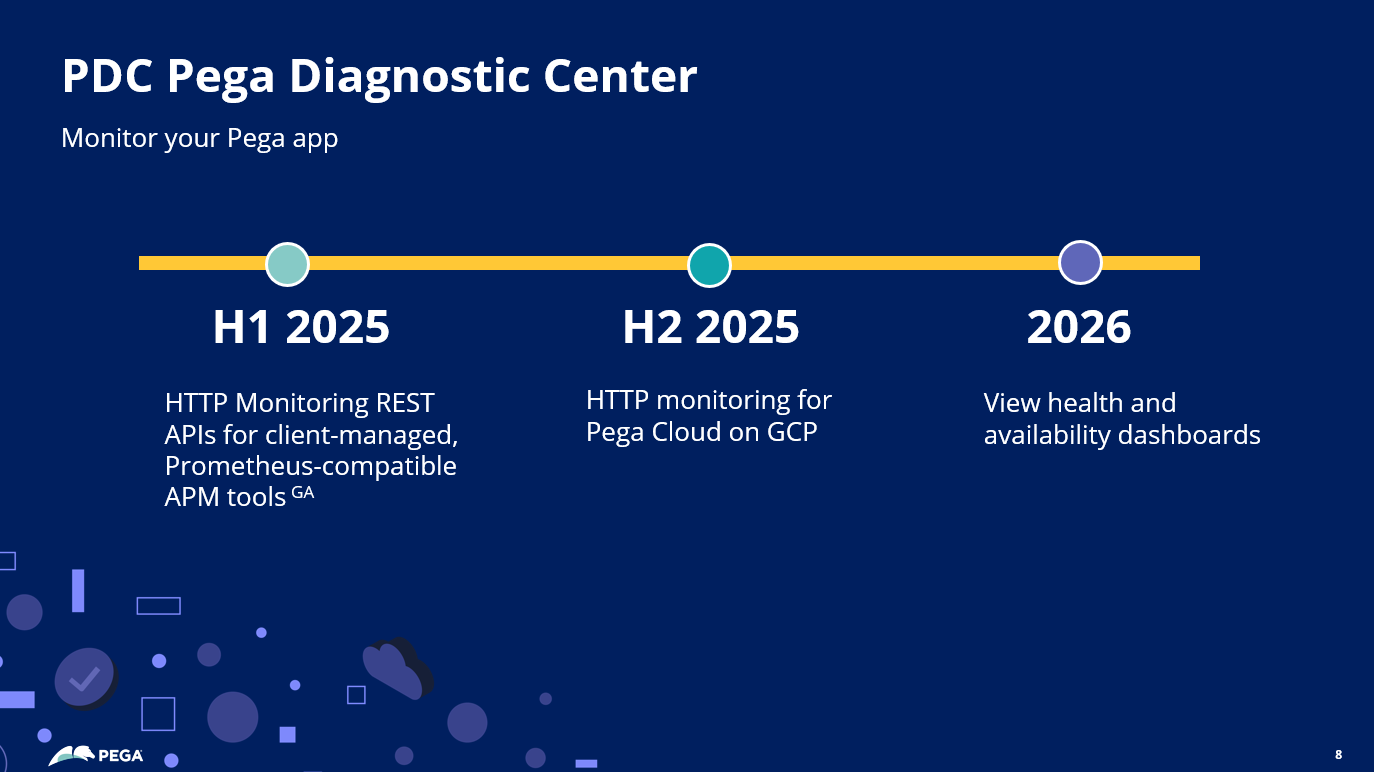Exclusive Insights into Pega's Q3 2025 Cloud Innovations
The third quarter of 2025 brought significant advancements to Pega Cloud, reinforcing our commitment to security, operational efficiency, and global accessibility. In our recent Ask-Me-Anything session, Satya Mishra, Senior Director of Product Management, walked us through the latest platform enhancements, cloud infrastructure improvements, and emerging capabilities that are reshaping how organizations leverage Pega as-a-Service.
If you missed the live session, you can watch the full recording here to get firsthand knowledge of upcoming features, strategic roadmap priorities, and how these developments will impact your operational efficiency and competitive advantage.
Global Expansion: Bringing Pega Cloud Closer to You
Pega Cloud now operates in over 41 regions worldwide, enabling businesses to expand to virtually any major market globally. This quarter saw the addition of several critical regions that are now live and ready for deployment, including Africa Cape Town, Australia Melbourne, Malaysia, and Saudi Arabia. Looking ahead to early 2026, we're planning to support Thailand Bangkok and Mexico Queretaro, ensuring that organizations can meet data residency requirements and deliver low-latency experiences to their users wherever they operate.
Beyond geographic expansion, Pega is making substantial investments in compliance boundaries. In partnership with AWS, we're launching the EU Service Boundary in 2026, also known as Sovereign Cloud, which addresses strict data sovereignty requirements for European markets. For our Canadian clients, we're working toward Canada Protected B certification—the equivalent of FedRAMP Medium—enabling government and regulated industries to leverage Pega Cloud with confidence. Additionally, we're expanding AWS GovCloud support to include the US East region, complementing our existing US West presence for FedRAMP-certified deployments.

Enhanced Disaster Recovery: True Multi-Region Resilience
One of the most significant announcements this quarter is the expansion of our Enhanced Disaster Recovery offering. Building on Pega Cloud's existing high availability within regions through multiple availability zones, this new capability provides true multi-region resilience for mission-critical applications. Organizations can now designate a primary region and a backup region with automatic synchronization and failover capabilities.
The offering delivers impressive recovery metrics: a Recovery Point Objective (RPO) of just 15 minutes and a Recovery Time Objective (RTO) of 150 minutes for production environments. This means that in the event of a complete regional outage or major disaster, your operations can resume in the secondary region with minimal data loss and downtime. Initially available for select AWS regional pairs supporting Pega Platform, Customer Service, and Sales Automation products, the service is expanding to US East 1 later this year and will support Customer Decision Hub in 2026.
Perhaps most exciting is the self-service testing capability coming later this year. Through MyPega Cloud, clients will be able to trigger failover tests on cloned environments, validate their disaster recovery processes, and generate compliance reports documenting RPO and RTO performance—all without raising support tickets or scheduling with operations teams.

Security by Default: A New Era of Network Protection
Security remains paramount in Pega's cloud strategy, and this quarter introduced transformative changes to how we approach network security. The "Deny by Default" feature now ensures that every newly provisioned client environment is isolated from the internet by default, requiring explicit configuration to enable connectivity. This security-first approach fundamentally shifts the paradigm from open-by-default to closed-by-default, significantly reducing the attack surface for new deployments.
MyPega Cloud now provides self-service network configuration capabilities, allowing clients to manage inbound connectivity, configure CIDR-based IP allow lists, and implement path-based restrictions for different application components. For organizations requiring even more control, our Advanced Networking offering enables granular management of outbound traffic for highly sophisticated use cases.
Satya emphasized the importance of choosing appropriate security postures: for applications that must be accessible via public internet, implementing CIDR-based IP allow lists at the application level is essential. For admin portals and sensitive endpoints, path-based allow lists provide an additional layer of protection. However, the strongest recommendation remains to leverage private connectivity offerings like PrivateLink whenever possible.

Self-Service Revolution: Empowering Teams Through MyPega Cloud
A central theme throughout the presentation was Pega's aggressive push toward self-service capabilities. The goal is clear: eliminate the friction of support tickets and empower clients to manage their cloud environments instantly through MyPega Cloud. This quarter saw the launch of several game-changing self-service features that dramatically reduce time-to-value.
The crown jewel is the fully self-service minor version upgrade journey. Previously, upgrading from one platform version to another (for example, from Infinity 24.1 to 24.2) required multiple support tickets, coordination with operations teams, and significant lead time. Now, clients can manage the entire process through MyPega Cloud: request a clone environment with the new version, conduct user acceptance testing, package any necessary fixes, schedule upgrades across environments, and even perform go/no-go decisions for production—all without external intervention.
Additional self-service enhancements launched this quarter include streaming logs to Azure destinations (complementing existing S3 and Splunk integrations), self-service inbound network configuration, and automatic detection of code changes triggering environment restarts. Deployment Manager also received significant updates, including global deployments capabilities allowing teams to build in one region and deploy across multiple regions worldwide, and automatic exposure of Pega maintenance schedules so teams can make informed deployment decisions.

Observability: The Future of Proactive Operations
Looking toward 2026, Satya outlined an ambitious vision for observability that leverages artificial intelligence and multi-layer correlation to transform how clients monitor and maintain their applications. The planned health and availability dashboards will provide a comprehensive view across all environments, with color-coded indicators for various system components including application availability, background processing, queue processors, job schedulers, search indexing, and MQ listeners.
What makes this truly innovative is the underlying intelligence. Pega will correlate data from network layers, storage systems, Kubernetes infrastructure, platform logs, exception data, and PDC monitoring to automatically detect issues, diagnose root causes, and even trigger self-healing actions when appropriate. The system will differentiate between client-side and Pega-side issues, automatically creating support incidents when infrastructure problems are detected, and providing diagnostic and remediation guidance when client action is required.
This represents a fundamental shift from reactive to proactive operations, where problems are detected before they impact users, and teams receive not just alerts but actionable insights on how to resolve issues quickly.

Looking Ahead: Innovation Pipeline for 2026
The roadmap discussion revealed several exciting capabilities planned for next year. For developers, a paid offering will enable moving production data to non-production environments with automatic data masking, addressing a long-standing need for realistic performance testing. Clients will gain the ability to download backups of their data for compliance purposes, configure log streaming through self-service, and view comprehensive storage consumption across database, case files, decision data, and SFTP usage.
For clients on GCP, the AWS Data Transfer Service will become available, providing a modern HTTPS API-based alternative to SFTP for file transfers. The platform upgrade experience will be enhanced with automated assessments and checklists, helping clients understand the work required before moving to new versions. Most intriguingly, Pega will leverage generative AI to analyze deployed applications and present only relevant release notes, filtering out information about products and features not installed in each environment.
Join the Conversation and Access Expert Resources
The innovations discussed in this session represent just the beginning of Pega's cloud evolution. As we continue to expand capabilities, improve security, and empower self-service operations, your feedback and participation become increasingly valuable. We invite you to join the Pega as-a-Service Expert Circle for access to additional webinars, direct engagement with product teams, and a community of cloud experts sharing best practices and insights.
Have questions about these new features or specific use cases for your organization? Join the conversation on the Pega-as-a-Service Expert Circle to continue the discussion. You can also send additional questions if you have any, and we'll address them in future sessions or through direct follow-up.
Recommended resources:
- Watch the full Q3 2025 Pega Cloud webinar recording
- Watch the My PegaCloud demo extract
- Read the Q&A from webinar (and ask any follow-up questions)
Don't Forget:
- JOIN THE CONVERSATION on Pega-as-a-Service Expert Circle
- FOLLOW @PegaDeveloper on X


